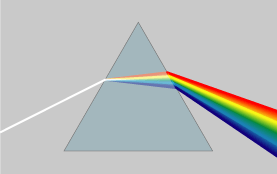Dispersion facts for kids
Dispersion is when a wave's speed changes depending on its frequency. You can see dispersion easily with light. When white light goes through a prism, it splits into all the different colors of the rainbow. This happens because each color of light travels at a slightly different speed inside the prism.
How Light Dispersion Works
When a beam of white light hits a prism, all the colors inside it slow down. But here's the interesting part: each color slows down by a slightly different amount. This difference in speed causes each color to bend, or "refract," at a unique angle.
- Red light bends the least because it travels fastest through the prism.
- Violet light bends the most because it travels slowest through the prism.
Because each color bends at a different angle, they spread out. This is why you see a beautiful spectrum of colors, just like a rainbow! The order of colors you see is always the same: Red, Orange, Yellow, Green, Blue, Indigo, and Violet (ROYGBIV).
Prisms and Rainbows
A prism is a special piece of glass or clear material that can split light. It's shaped in a way that helps separate the colors. Think of it like a traffic jam for light, where some cars (colors) get through faster than others.
You can see dispersion in nature too! Rainbows are a perfect example of light dispersion. When sunlight passes through tiny water droplets in the air, these droplets act like tiny prisms. They split the white sunlight into all the colors we see in a rainbow.
See also
 In Spanish: Dispersión para niños
In Spanish: Dispersión para niños


